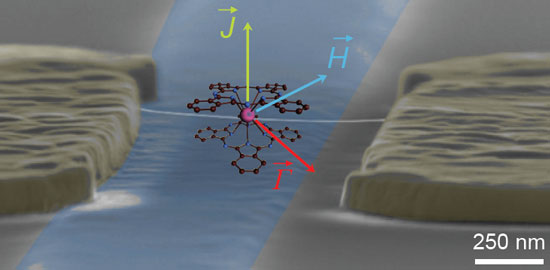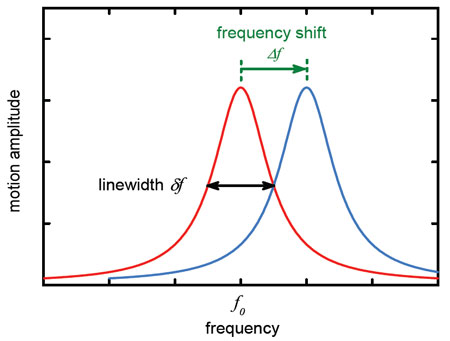| Posted: Jul 19, 2013 | |
Probing single-molecule magnets with carbon nanotube NEMS |
|
| (Nanowerk Spotlight) Electronics will undergo revolutionary changes as the relatively novel disciplines of spintronics, nanoelectronics, and quantum computing come of age. A fundamental link between these fields can be established using molecular magnetic materials and, in particular, single-molecule magnets (see: "Molecular spintronics using single-molecule magnets"), which combine the classic macroscale properties of a magnet with the quantum properties of a nanoscale entity. The resulting field, molecular quantum spintronics, aims at manipulating spins and charges in electronic devices containing one or more molecules. | |
| "The magnetism of a nanoscale object, like single molecule magnets or atoms, is typically governed by the laws of quantum mechanics," Wolfgang Wernsdorfer, a researcher in the Nanosciences Department at the Institut Néel, CNRS, in Grenoble, explains to Nanowerk. "Various quantum effects ranging from tunneling processes to coherent phenomena have for instance been observed in single molecule magnets. Probing the quantum nature of such molecular magnets however remains a challenging task and requires the use of an appropriate magnetometer, preferably one with molecular dimensions itself." | |
| Over the past few years, researchers have proposed various detector designs for individual single-molecule magnets. One, for instance, is a hybrid spintronic nanodevice where the state of the molecule is measured 'indirectly' (as compared to a measurement where the electric current is flowing directly through the molecule), through a graphene-based sensor coupled with the magnetic molecule (read more: "Single-molecule nanomagnets enable novel graphene spintronics devices"). | |
| Apart from graphene, another highly suitable candidate for such a nanoscale magnetometer is a mechanical oscillator based on a suspended carbon nanotube (CNT). The strong coupling between a magnetic molecule and the CNT opens the path towards magnetometry with single molecule sensitivity. | |
| In new work, Wernsdorfer and his team have demonstrated how to noninvasively graft a single-molecule magnet onto a carbon nanotube nanoelectromechanical system (NEMS) and probe the molecular nanomagnet with the carbon nanotube's mechanical motion at cryogenic temperatures. They reported their findings In a recent paper in ACS NANO, ("Carbon Nanotube Nanoelectromechanical Systems as Magnetometers for Single-Molecule Magnets"). | |
 |
|
| Fig. 1: Carbon nanotube NEMS as magnetometer for molecular magnets. (a) False color SEM image of a carbon nanotube NEMS with a local metallic backgate (blue) functionalized with a molecular magnet (shown as a chemical structure overlaid on the image). Under the influence of a magnetic field H (blue arrow), the molecular magnet yielding a magnetic moment J (green arrow) will experience a magnetic torque Γ (red arrow). By changing the magnetic field, one can therefore induce a change in the molecule's magnetic torque. If the molecular magnet is rigidly grafted to the carbon nanotube NEMS, a change of the torque will induce an additional tension in the carbon nanotube beam, resulting in a shift of its resonance frequency. (Reprinted with permission from American Chemical Society) | |
| The researchers built their CNT resonators in a bottom-up, ultra clean fabrication process. First, they patterned adjacent platinum electrodes separated by a deep trench. In a second step, they then grew carbon nanotubes in a CVD process directly over the previously fabricated trench. | |
| In a final step, they then functionalized this CNT-based oscillator with molecules carrying a well defined magnetic moment. | |
| This particular process ensures the best mechanical properties for the CNT resonator and also conserves the magnetic properties of the magnetic molecule. | |
| "The magnetization reversal of the molecule results in a change of current in the carbon nanotube oscillator," says Marc Ganzhorn, a PhD student in Wernsdorfer's group and first author of the paper. "In order to probe its magnetic moment, the magnetic molecule has to be studied at temperatures below 1K using an electronic readout technique. The result of these measurements then reveals the nuclear spin of the molecule itself, indicating a strong interaction between the molecule and the nanotube's mechanical motion." | |
 |
|
| Fig. 2: Shift of the carbon nanotube NEMS' resonance frequency by the molecule's magnetic torque in the setup depicted in Fig. 1. (Reprinted with permission from American Chemical Society) | |
| "Our results provide the first experimental evidence for the detection of a single spin by a mechanical degree of freedom on a molecular level and the first implementation of a molecular magnetometer based on a carbon nanotube NEMS," says Wernsdorfer. | |
| He adds that, going beyond simple magnetometry, such a device could be used to manipulate a magnetic molecule with a carbon nanotube resonator and vice versa, which would reveal various quantum mechanical effects such as quantum coherence. | |
 By
Michael
Berger
– Michael is author of three books by the Royal Society of Chemistry:
Nano-Society: Pushing the Boundaries of Technology,
Nanotechnology: The Future is Tiny, and
Nanoengineering: The Skills and Tools Making Technology Invisible
Copyright ©
Nanowerk LLC
By
Michael
Berger
– Michael is author of three books by the Royal Society of Chemistry:
Nano-Society: Pushing the Boundaries of Technology,
Nanotechnology: The Future is Tiny, and
Nanoengineering: The Skills and Tools Making Technology Invisible
Copyright ©
Nanowerk LLC
Translate this article:
|
|
|
Become a Spotlight guest author! Join our large and growing group of guest contributors. Have you just published a scientific paper or have other exciting developments to share with the nanotechnology community? Here is how to publish on nanowerk.com. |
|
